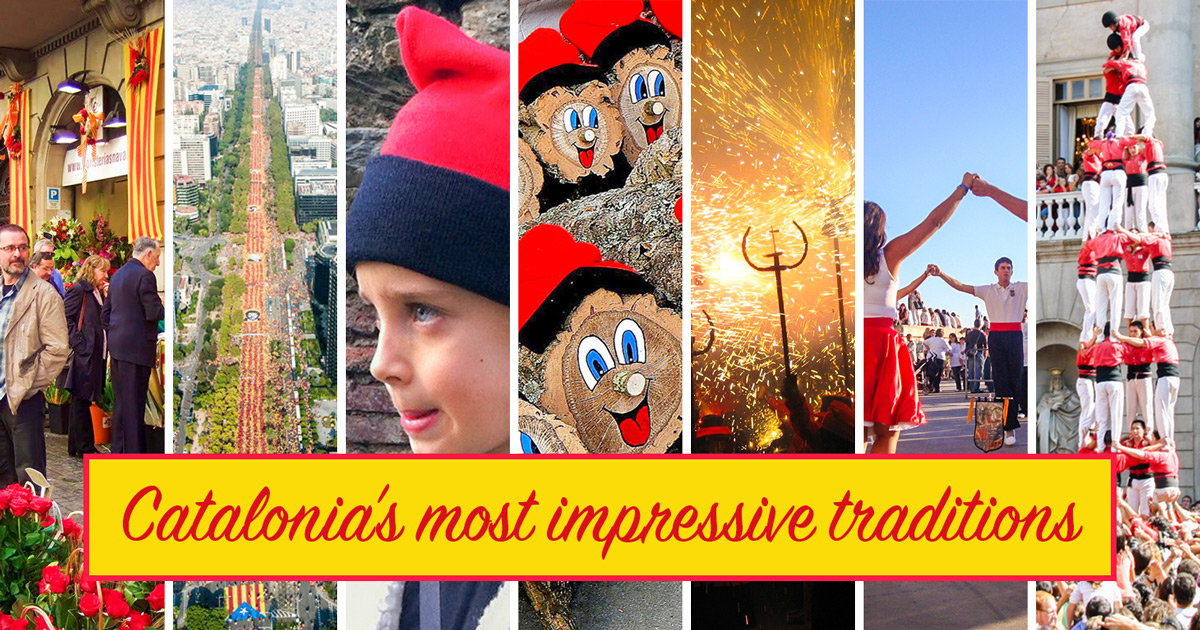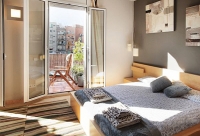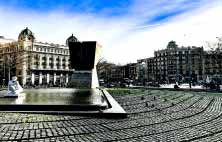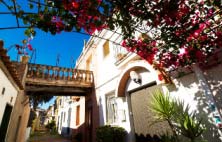Infographic: The results of the survey
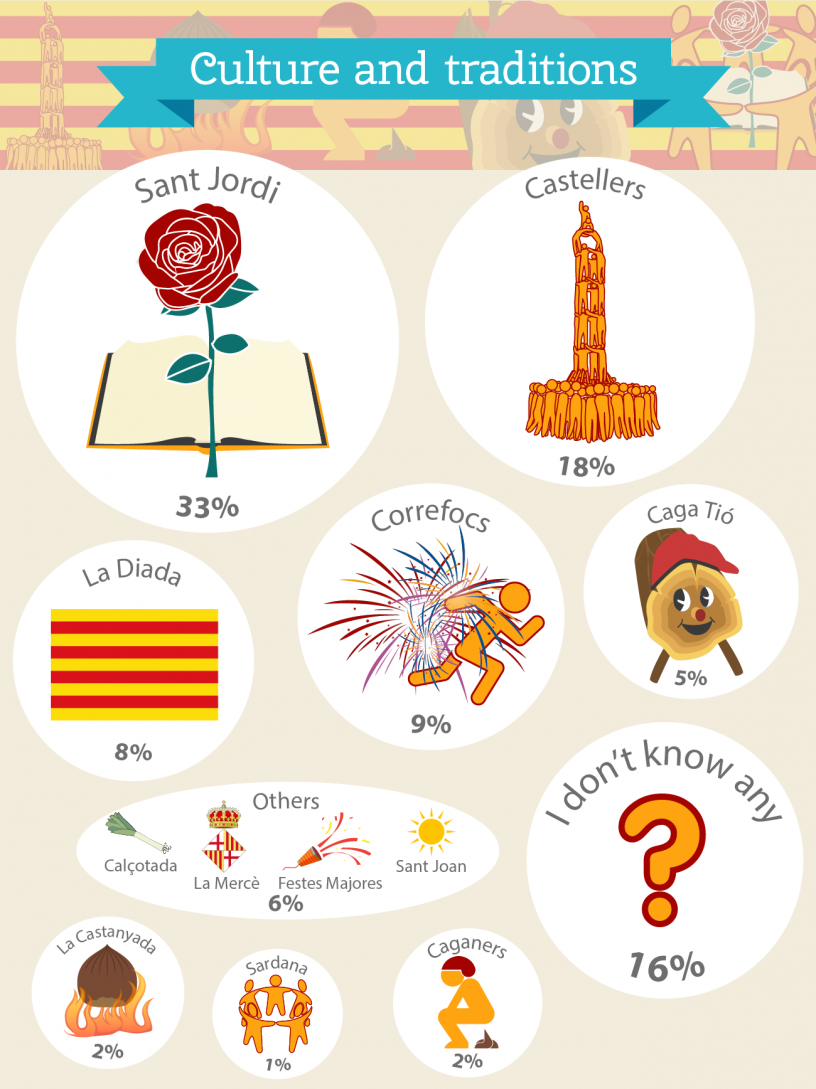
1. Sant Jordi celebrations
Sant Jordi, known in English as Saint George, has been the patron saint of Catalonia since 1094 and over the years, St. George's day has become a traditional and exciting celebration in which lovers exchange roses and books. It's a popular and peaceful holiday, exalting human values such as love, culture, and patriotism.
Roses and books, which are given to each other loved ones, fill the streets and squares of all cities and towns in Catalonia upon thousands of temporarily set up stalls. It's one of the most popular celebrations and participation is almost mandatory for visitors since it is a unique experience. It's not a public holiday however, so you'll find that while people are celebrating, most Catalans will be working.
Sant Jordi is the saint of lovers in Catalonia, stealing in some sense of the word, almost all the attention from Saint Valentine here. Almost all people living in Catalonia take part in some way, and though traditionally the man gives the woman a single red rose with a strand of wheat, and the woman gives her beloved a book, these days you can find men giving men roses, women giving men roses, men giving women books, women giving women books, and so on. There are no real set rules. Books were a more recent addition to the festival, but it is still a centuries-old celebration. It's also a fact that in 1995, UNESCO, influenced by the Sant Jordi celebration amongst other things, declared 23 April World Book Day.
The special nature of this day, the expression of the people, joy and festivity that is breathed in the streets is contagious and pleasant. For this reason, this tradition is one of the most enjoyed by foreigners living in the city: one in three respondents say it is their favourite from many. In the following link you can watch a video of Sant Jordi that we made.
-
 Sant Jordi - Catalonia's Valentine's Day Apr 23 Enjoy Barcelona like never before as they celebrate St. George's Day!
Sant Jordi - Catalonia's Valentine's Day Apr 23 Enjoy Barcelona like never before as they celebrate St. George's Day!
2. Castellers
The Castellers are also a very popular tradition according to the results of our survey, it actually comes in second position with 1 in 5 of the votes. "Castell" means castle in Catalan. The aim of this cultural activity is to build a human castle. To form this tower, there are three parts: the "pinya", the "tronc" and the "pom de dalt". The "pinya" is the foundation of the castle, which stabilizes the structure and acts as a cushion in case of a fall. The "tronc" is the central part of the tower and on every floor comprises of 1 to 9 people depending on the construction. The "pom de dalt" is the top of the castle where the "Enxaneta" climbs up and makes a gesture called and "Aleta". The Aleta gesture (traditionally) signifies the official completion of the castell, though rules are more liberal today.
An Enxtaneta is always a child due to agility and weight requirements, which allows them to climb up and down more easily. In some types of Castells, they may have added bases in on top of the pinya, a second level foundation is called "folre", and for the most impressive Castells, there is a third level foundation called a "Manilles". People involved in this tradition are the Castellers and they are usually found in major celebrations around the city, like the Festas Majors.
3. Correfocs
The Correfocs are an unusual tradition in Barcelona. These types of celebrations are appreciated not only amongst the Catalans but also expats, with 1 in 10 respondents naming it as a favourite, thus placing third. The origin of the Correfocs date back to the 12th Century, but during the Franco dictatorship it was banned. Today it has evolved and become a recognized public celebration across Catalonia. You'll see people dressed as devils and demons running with fireworks, dancing to music, or occasionally swallowing fires. Generally, residents also participate in the event by throwing firecrackers and other fireworks. This tradition takes place as part of La Merce, Sant Joan, and the Festes Majors of neighborhoods (neighbourhood annual celebrations).
4. Diada Nacional
The National Day, ranked alongside the correfocs, with 1 in 10 citing it. The history of the tradition of this day dates back to 1714, from the war between the Bourbons and Hapsburgs. King Louis XVI of France won the battle with the support of Castile and most of the Spanish courts to put a Frenchman on the throne in Madrid. Catalonia was on the opposing side along with Valencia and Aragon, as they enjoyed political freedom with the Hapsburgs rule. Barcelona become a point of resistance and a strategic point of the battlefield, but it eventually fell on 11 September 1714. It was then that the city of Barcelona was taken by the Franco-Castillian troops.
Since then, every year the Catalans commemorate what is known for many locals as a loss of political independence of Catalonia. It has been a public holiday since it was proclaimed as the "National Day" of Catalonia in 1980. The tradition has consisted of laying flowers on the monuments to Rafael Casanova and Josep Moragues, who were killed defending the Hapsburg vision of Spain. It's common to see Catalan flags on the balconies of homes. Due to the meaning behind National Day of Cataonlia, the day is used as a vehicle for the independence movement to gather mass demonstrations, which garner support and public attendance in the millions (see picture below - first two images on top left). It is also a chance to hear Catalonia's national anthem, "Els Segadors".
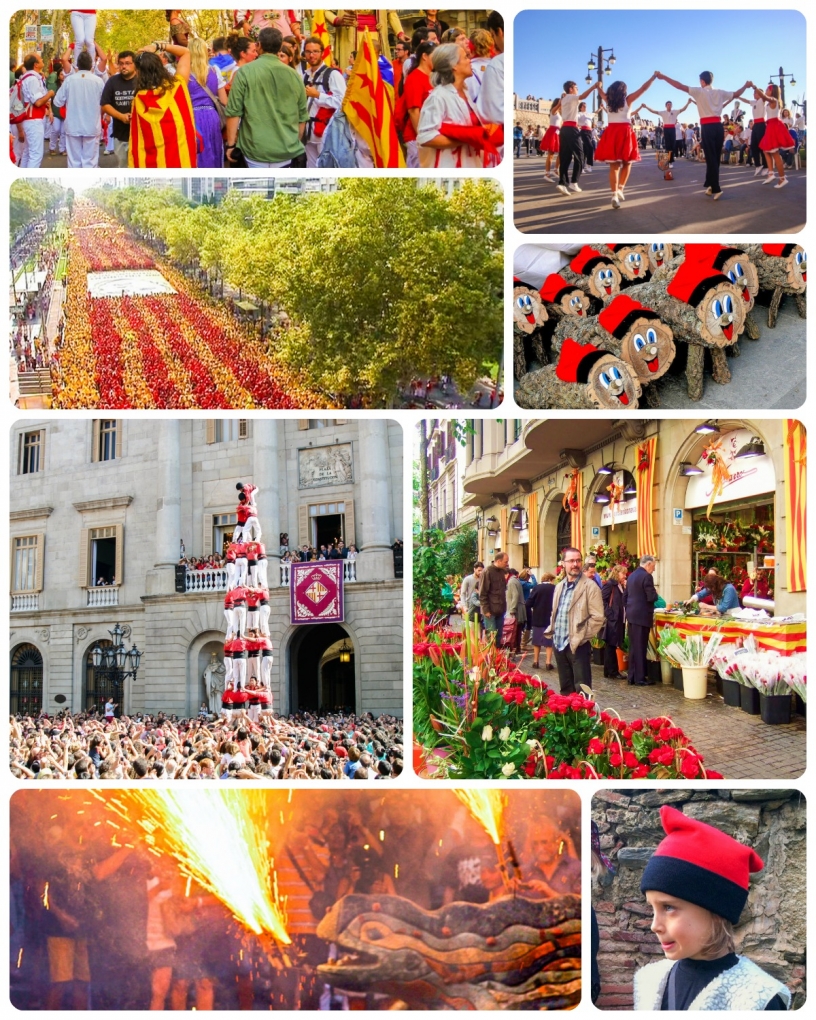
If you are coming to study in Barcelona we advise you to look at our cheap student apartments in Barcelona.We offer apartments of different types, renovated and well furnished in all areas of Barcelona!
5. Have a Caga Tiò Christmas
Caga tió means "Pooing Log" in Catalan and is the base of a quirky tradition. Originally, the log was symbolic as a source of heat in the home. Today, it is a wooden anthropised representation of a log with a trunk about 0.3 meters long, 2 or 4 pieces of wood that serve as hands and legs, a red nose of wood, large drawn eyes, and a traditional hat called a Barretina. This wooden character is called Caga Tió. In this tradition, he is brought out on 13 December at the start of the 12 days of Christmas. From that day until Christmas, the family - particularly the children - take care of this character by feeding him and keeping him warm with a blanket.
Parents will secretly hide presents under the blanket on Christmas eve. Yes, in Catalonia there is not Santa Claus, presents are delivered by defecating logs. On Christmas day, the family order Caga Tiò to defecate by hitting it with sticks and chanting (translated to English from Catalan) "Poop log, hazelnuts and nougat, don't poo sardines, those are salty. Poo nougat which is much better. Poop log, almonds and nougat, if you don't poo I will hit you with a stick!". Much to the surprise of the children, when they lift the blanket they see how the presents have arrived!
6. Castanyada
The Castanyada is a Catalan tradition that was mentioned by some respondents. It is a festival on 31 October, on the eve of All Saints. Initially, it was a custom of medieval times, when families would eat seasonal produce after paying tribute to their departed relatives. Today, this tradition has preserved the culinary customs of the time, in fact, on this day the Catalans often eat seasonal products as:
- chestnuts and roasted chestnuts. You'll find chestnuts in corners, wrapped in paper.
- Sweet potatoes . Also can enjoy sweet potatoes, which are the hot sweet potatoes, cooked over a wood fire with chestnuts, grilled or baked.
- Panellets. This is typical Catalan sweets. You'll find different tastes like pine nuts, chocolate and even shredded coconut.
- The moscatell. It is a sweet wine made from a variety of specific grape of the same name and very mature collection.
You can learn more about "The Catalan Halloween" in our article about the Castanyada.
7. Sardana
The Sardana is a lesser-known tradition, but it did get a few mentions. It is a group circle dance. Its Mediterranean origins date back to the first century. The Sardana is danced accompanied by a flute and "Cobla" - a Catalan ensemble, the dancers then dance in a circle and hold hands. It is a simple Catalan tradition in which everyone can participate. There are still certain rules. This dance is simple but you have to keep pace; the steps follow each other quickly. This tradition has been hailed throughout the 19th Century. At that time the Catalans claimed their identity and this dance became one of its symbols, so in some sense it remarks a strong cultural difference with the rest of Spain. You can find usually find official representations of this dance at La Merce. Although every Sunday around the city, locals gather outside Barcelona Cathedral to hold a public Sardana dance.
Some traditions were mentioned in the "other" section in our survey, representing in total about 1 in 20 of respondents, we discuss these three traditional events of Catalonia: Sant Joan, Calçotada and Festes Majors.
8. Sant Joan
The night of June 23 each year is the celebration of Sant Joan, which was originally a pagan festival. The cities around Catalonia and neighborhoods celebrate the arrival of summer with fireworks, bonfires, and firecrackers. Originally, this tradition was for cleansing from fire and water, and to give more power to the sun. In Barcelona, this festival is celebrated mainly on beaches where there is music and groups of friends / families gatherings.
-
 San Juan Barcelona 2016 Jun 23 - Jun 24 Enjoy a magical evening on one of the beaches of Barcelona for the Sant Joan.
San Juan Barcelona 2016 Jun 23 - Jun 24 Enjoy a magical evening on one of the beaches of Barcelona for the Sant Joan.
9. Calçotada festival
The Calçotada is, by definition, the traditional event to eat calçots, a unique leek/scallion grown exclusively in southern Catalonia. Since their birth in the town of Valls, Calçotadas are a friendly, usually public, party spent with family around the beginning of the year from January to April. In fact, if you are in Barcelona during the last Sunday of January, you can visit the Great Feast of the Calçotada of Valls, the origin of the celebration. They are flame grilled after cutting the unwashed green tips of the leaves of spring onions. Once cooked, the calçots are wrapped in paper and will be served at the table to be shared. The authentic way to taste them is accompanied by a salvitxada sauce made primarily for this festival, consisting of almonds and toasted pine nuts, tomatoes, and olive oil. Wine is served in a Porrón, a special jug of wine. The ritual for eating Calçots is with the hands, not forgetting a bib tied around the neck... (It can get messy!)... You remove the charred outer leaves, peel the calçot from the tip, and dunk it in the sauce before eating from the bottom up.
10. Festes Majors
The major annual neghbourhood festivals are local celebrations that take place throughout the year. Although the dates are different in across Catalonia, each neighbourhood annually celebrates their own patron. A Festa Major lasts several days and offers many activities like street concerts, Castellers, Gegants (Giants) parades, and dances. There's also fireworks and sometimes an aforementioned Correfoc. The Festa Major de Gracia or "les Festes de Gràcia" is one of the most famous and takes place mid-August. As part of it, neighbours on each street launch into a competition to theme their street with the most original decorations. At the end of the week, a street is chosen as the winner. You can also find beer tasting and public meals with neighbours, who can sometimes be seen wearing the colours of their neighborhood, so you can go specially dressed for the occasion with the colors too!.
Excursions in Barcelona
To make the most of Barcelona and fill your trip with unforgettable experiences and emotions, we offer you the excursions through the Catalan capital organized by our friends - the GetYourGuide team. Choose your excursion and fall in love with Barcelona:

